Deep Sea Corals Resilient to Impacts
Air Date: Week of March 11, 2022
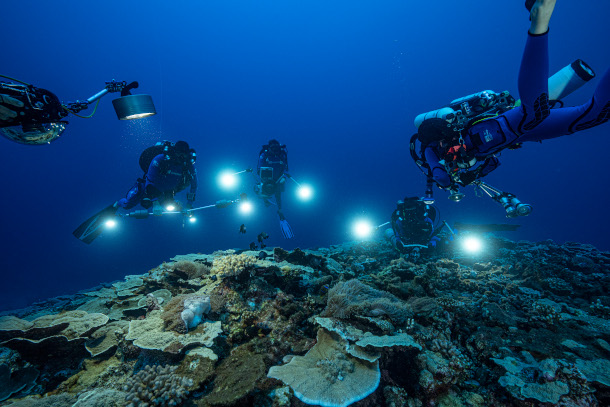
It is possible that the discovery of these deep-sea corals, which have been largely unaffected by warming oceans, could help in efforts to preserve reefs in more shallow water. (Photo: @alexis.rosenfeld, supported by UNESCO)
In Tahiti, researchers recently discovered one of the largest deep sea coral reefs in the world, spreading for roughly two miles at up to 230 feet deep. It’s in pristine condition, with no evidence of stress from pollution, ocean acidification, or warming water that has killed roughly half the world’s coral reefs in the last 70 years. Laetitia Hedouin made the discovery as a researcher at the Center for Island Research and Environmental Observatory and discusses her findings with Host Bobby
Transcript
DOERING: It’s Living on Earth, I’m Jenni Doering
BASCOMB: And I’m Bobby Bascomb. Most of us probably think of coral reefs in shallow tropical waters, often easy to see with just a mask and snorkel. But around the world researchers are finding coral reefs in one of the least explored parts of our planet, the deep ocean. Corals can actually be found in water up to 10,000 feet deep, with no access to light. In Tahiti researchers recently discovered one of the largest deep sea coral reefs in the world, spreading for roughly two miles at up to 230 feet deep, in an area known as the twilight zone with very little sunlight. It’s in pristine condition, with no evidence of stress from pollution, ocean acidification, or warming water that has killed roughly half the world’s coral reefs in the last 70 years. Laetitia Hedouin made the discovery as a researcher at the Center for Island Research and Environmental Observatory and she joins me now for more. Laetitia, welcome to Living on Earth!
HEDOUIN: Thank you.
BASCOMB: So how did you first find these deep coral reefs near Tahiti?
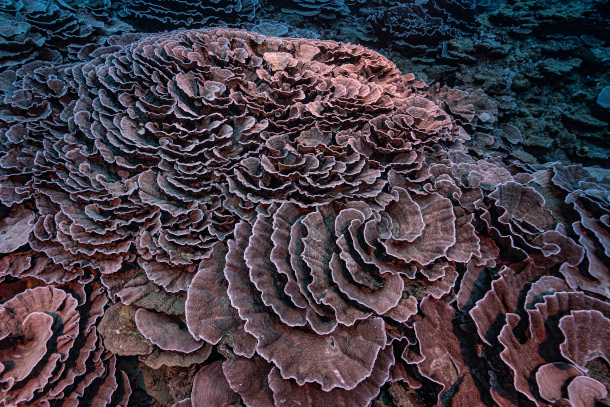
The deep sea corals discovered in Tahiti are called “rose” corals for their intricate formations. (Photo: @alexis.rosenfeld, supported by UNESCO)
HEDOUIN: Well, the first time I heard about it, it was from some diving club. The people were diving there, and they mentioned, "Oh, Laetitia, you should go," like, "the spot looks amazing but we need to have your point of view as coral biologist." And when I arrived at this spot at 40 meter, it was like, Oh, my God, it's incredible! The corals were just gigantic, like they were everywhere, and they were this rose shape that is like, very beautiful. And it's common at depth, but like, not that much and not that size. So I was very impressed. So when we came back at the surface, I was like, oh, but we really need to do a scientific study. There is really something different about that spot, about that area. And I had, like, so many questions that I was like, Okay, we need to do something.
BASCOMB: So how big is the area and what is the depth you were diving in?
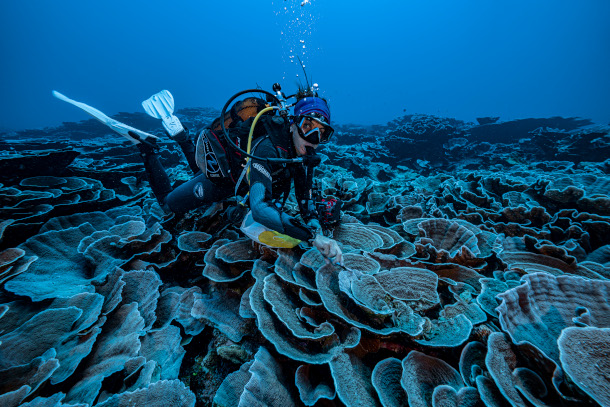
The enormous size of the corals indicates that they are at least two decades old, researchers report. (Photo: @alexis.rosenfeld, supported by UNESCO)
HEDOUIN: So I think one of the things very interesting about that reef, is that like there is one species that live from 30 to 40 meter that is called Porites rus. And it's a species that we used to know from the lagoon side, and they form branching colonies, and you can find them everywhere in the bay, in the lagoon and stuff like that. And when you go on the site, like at 30 meter, this coral looks like a plate, like and they form like the different plates arranged together to form this big roses shape that we call the rose coral. So it's very impressive in terms of biology to realize that you have this coral, the same species that could change its morphology with the depth and because the light is becoming limiting at depth, so they kind of change their shape to really be able to capture the few light that is arriving at that depth. So one thing that was very impressive for me. Something more in terms of biology is that at some point, when you go deeper, at 45 meter, 50 meter, you can find one rose that is made of two different species. One is Porites rus, and one is Pachyseris. So the two species kind of correlate together to form this big rose shaped colony that you can see. So it's very interesting, and I was really fascinated by discovering this coral and this landscape.
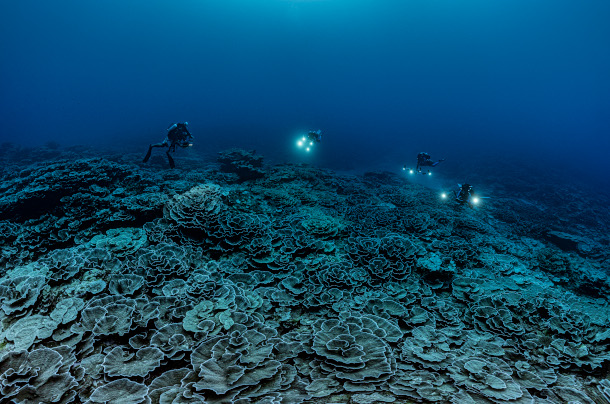
The corals are located in what is known as the twilight zone, an area of the ocean with very little sunlight. (Photo: @alexis.rosenfeld, supported by UNESCO)
BASCOMB: Of course, we know that worldwide, coral reefs are in serious decline from rising ocean temperatures and coral bleaching. Roughly half have actually died since the 1950s. And the future doesn't look good. But from what I understand this deep coral in Tahiti is actually quite healthy and in really good condition. To what degree do you think the depth is protecting it from climate change and warming water?
HEDOUIN: Yeah, that was one of the information that for me was very important is like, the size of the colony was very big, somewhere like two meter diameter. And we know that coral, when they live deeper, they'll grow smaller. So when you have that size of coral, they are approximately 20 years old, at least. So this means that we have been going for the last two decades without any insert from thermal stress, global warming, it didn't affect that. I believe that the main reason is like the light because like the bleaching is really a reaction to what we call oxidative stress. And that oxidative stress is due to the high temperature that is combined to a high light intensity, that generate like that oxidative stress. So if you reduce one part of the stress, that will be the high light, then they will be able to kind of face the heat stress that they will have. So because in the deep, they will just have the heat stress and normally, they can bleach but they can recover. And I believe that's the reason why today we don't find any sign of mortality on that reef. So the depth is kind of protecting them from like the bleaching event. And potentially it will not protect them forever, because it really, really depends of the intensity and the frequency of the future heat stress that will occur on Earth. But until now in French Polynesia it's really like a trend that we observe, that the deeper reefs have been protected from climate change.
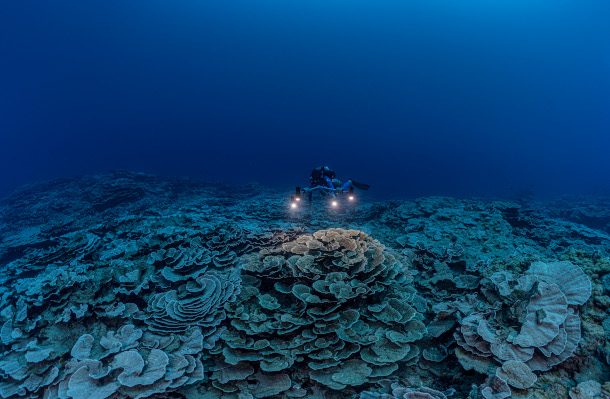
While about half of the Earth’s coral reefs have died in the last 70 years, the corals discovered in Tahiti are thriving—a phenomenon that is intriguing scientists. (Photo: @alexis.rosenfeld, supported by UNESCO)
BASCOMB: What are some of the potential impacts of this discovery? I mean, how possible is it that deep sea corals like this can be helpful with coral restoration in more shallow water?
HEDOUIN: So, one of the theory and hypothesis is the reason that deeper corals is that because like they share like similar species as the shallow reefs and we have been watching spawning on the deeper reef for this species of Porites rus, so if they are spawning, you can have baby corals from like the deeper reef that will come and that will settle in the shallow reef that are really impacted or degraded. So they could be like a natural source of new baby coral that will help the resilience of the coral on the surface that has been degraded. So that's the first point. And also I think there is like a way to see also this part of the reef that we need to study because potentially they could serve our nursery for like some fish or some other organism that are key also for like the shallow water reef. Also what we think is that we put into the light this coral, this area of Tahiti, but we think that if we do more dive in Tahiti, we have the potential to discover more area like that. I think we just don't have at that time the knowledge of how diverse these deeper reef are and how abundant they are, and I think there is really a need to better identify where they are because they could be key target to help the resilience of other coral reefs.
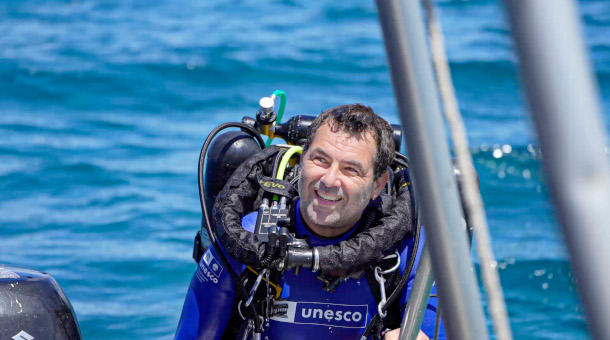
Alexis Rosenfeld, supported by UNESCO, took these stunning underwater photographs. (Photo: @alexis.rosenfeld, supported by UNESCO)
BASCOMB: Laetitia Hedouin is a researcher at the Center for Island Research and Environmental Observatory in French Polynesia. Laetitia, thank you so much for taking this time with me today.
HEDOUIN: Thank you, goodbye.
Links
UNESCO | “Rare Coral Reef Discovered Near Tahiti by a UNESCO Mission”
UNESCO | “Rare Coral Reef Discovered Near Tahiti by A UNESCO Mission (Video)”
United Nations | “Rare Coral Reef Discovered Near Tahiti Is ‘Like A Work of Art,’ Says Diver”
EcoWatch | “New Reef Discovered in Deep Waters off Tahiti is a Rare ‘Positive Story’ for Corals”
Living on Earth wants to hear from you!
Living on Earth
62 Calef Highway, Suite 212
Lee, NH 03861
Telephone: 617-287-4121
E-mail: comments@loe.org
Newsletter [Click here]
Donate to Living on Earth!
Living on Earth is an independent media program and relies entirely on contributions from listeners and institutions supporting public service. Please donate now to preserve an independent environmental voice.
NewsletterLiving on Earth offers a weekly delivery of the show's rundown to your mailbox. Sign up for our newsletter today!
 Sailors For The Sea: Be the change you want to sea.
Sailors For The Sea: Be the change you want to sea.
 The Grantham Foundation for the Protection of the Environment: Committed to protecting and improving the health of the global environment.
The Grantham Foundation for the Protection of the Environment: Committed to protecting and improving the health of the global environment.
 Contribute to Living on Earth and receive, as our gift to you, an archival print of one of Mark Seth Lender's extraordinary wildlife photographs. Follow the link to see Mark's current collection of photographs.
Contribute to Living on Earth and receive, as our gift to you, an archival print of one of Mark Seth Lender's extraordinary wildlife photographs. Follow the link to see Mark's current collection of photographs.
 Buy a signed copy of Mark Seth Lender's book Smeagull the Seagull & support Living on Earth
Buy a signed copy of Mark Seth Lender's book Smeagull the Seagull & support Living on Earth

